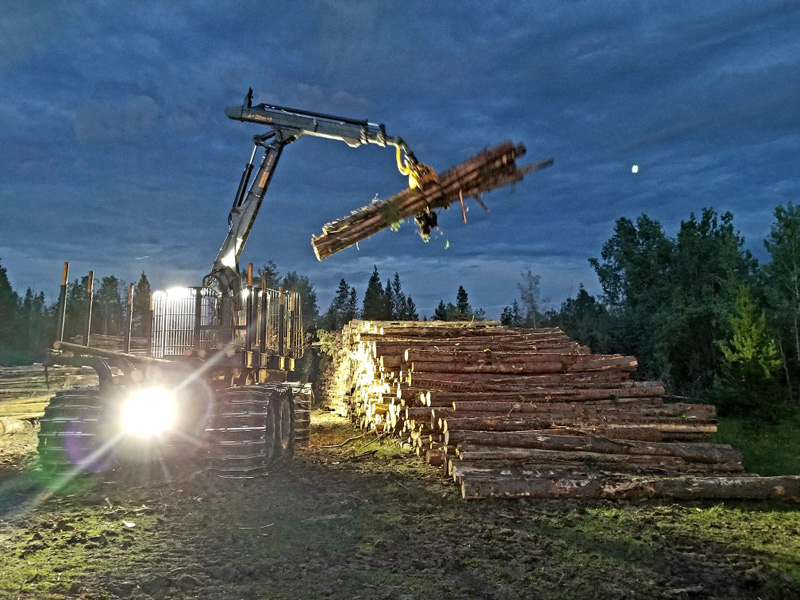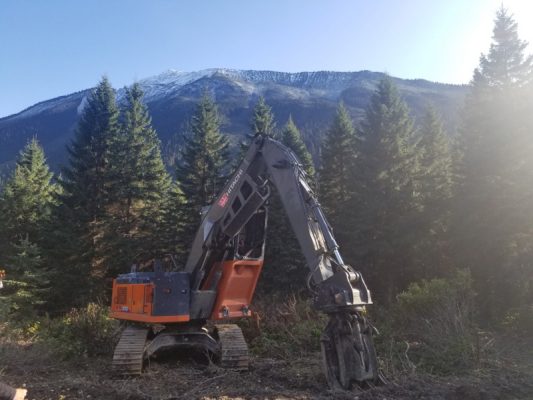
differences from logging shows forest professionals are used to seeing in the valley. /SUBMITTED
By Andru McCracken
Logging contractor Liam Parfitt says that Swedish forest practices can allow the forest to grow faster, make marginal stands more valuable, provide vastly better conditions for wildlife and create much more work in the forest. Parfitt is the owner of Freya Logging Inc. and has had the opportunity to test his claims right here in the Robson Valley. His work is being closely monitored by many partners, including the Ministry of Forests, licensee Carrier Lumber, and FPInnovations.
Freya Logging was contracted by Carrier Lumber to conduct a trial of thinning, commonly done in Sweden in immature stands; one of the test sites was a clear cut up the Holmes River that was logged in 1974 and planted in 1977.
The stand wasn’t promising. Two years ago, local logging contractors need to get to “good wood” beyond the area Parfitt was charged with treating.
“They bulldozed the wood that we were turning into sawlogs,” said Parfitt.
Freya Logging’s treatment was simple, if delicate. They logged 5 metre swaths every 20 meters allowing their European harvester to reach into the forest and pluck out unhealthy stems on either side, thinning the dense stand. The delicate part is getting the stems out without destroying the forest around it. In Europe, equipment operators are certified over a two year course, something closer to a Registered Forestry Technician than a North American equipment operator.
“The point of the logging is to enhance the stands,” said Parfitt. “We were targeting a lot of crooked trees and double forked trees.”
At the outset, only 30% of the trees were of high quality, when they finished 70% of the remainings trees were high quality.
“There are a bunch of other cool things about it: (when) you have a really dense stand, you don’t have any light on the forest floor,” he said. “When we’re done, we’re going to see a dramatic increase in moose browse because we’re getting sunshine on the forest floor.”
The equipment and expertise to do the work is uncommon. While he tried to use as much local help as possible, Parfitt hired operators from Europe to get the main work done.

“Unfortunately it’s a pretty skilled business and very capital intensive. We’re talking almost a million bucks for one of these machines,” he said.
With payments of $70,000 per month, the work schedule is upwards of 3000 hours a year and even then margins are slim, but Parfitt believes it is the way forward.
Jason Gordon, a forester for Carrier Lumber hopes he is right.
“The concept is, you go into a stand that has some forest health concerns in this case, spruce leader weevil and you select cut poor quality stems. Europeans have been doing this for decades and we’re just starting to do it.”
The result, he said, is visually appealing.
“It’s not another clearcut, there’s lots of biodiversity left and it allows some of the brush species to come up, allows for more browse (food for deer and moose) and makes it easier to walk through,” said Gordon.
“This is a research trial and the first crack at it for us, it could be brought forward more extensively.”
He said similar practices have been used in the province where five metre strips were logged in a block, but what is interesting and new is that operators are able to reach far into the forest to remove unhealthy trees throughout the block.
“We are trying to focus on silviculture improvement instead of maybe a fibre grab,” said Gordon.
He said the company was looking for both saw logs and ‘bio logs’ or logs that would be turned into pulp or bioenergy.
“We need customers for both to do it,” he said. “You get 40 to 60 percent pulp wood, so you need a very strong pulp market.”
Gordon said that the project wasn’t government subsidized and because the project was adding value to the stand, the sawlogs they did take were valued at minimum stumpage rates.
Gordon said the Swedish method only works on a limited number of stands. They need to be the right age.
“You have a limited ability to influence a stand by thinning and getting medium size trees to grow fast. Too early or too late doesn’t work,” he said. “We worked all summer with Optimum Resource Management finding the stands.”
The practice also dramatically increases the amount of work.
“You enter the stand three times and get way more volume per hectare and generate way more jobs than otherwise,” he said.
That means clear cutting, thinning half way through the growth cycle of the forest and clear cutting again.
Gordon said they need government policy to support the practice and that a little encouragement from the public would go along way too.
“We’re really lucky we had a contractor that was keen to adapt who brought folks over to help with that. We’re learning a lot,” he said.
The project is getting attention locally.
“I was impressed. The stand looked good in the end and [I am] confident that in the future the stand would flourish,” said Craig Pryor, manager of the Valemount Community Forest.
Ray Thiesen, manager of the McBride Community Forest agreed.
“The younger thinned stands have an opportunity to increase increment with greater access to light, nutrients and moisture,” said Thiesen, though the work requires slopes less than 35% which are hard to find in the valley.
He said that over the next 10 years MCFC will have stands in that age range and that they hope to explore the possibilities.
Parfitt married a Swede and has spent time seeing the practices first hand and is a wealth of information.
In our next story on Swedish style commercial thinning, we’ll fact check some of the benefits claimed… which are remarkable, including the impact on moose population, forest productivity, and carbon sequestration.



